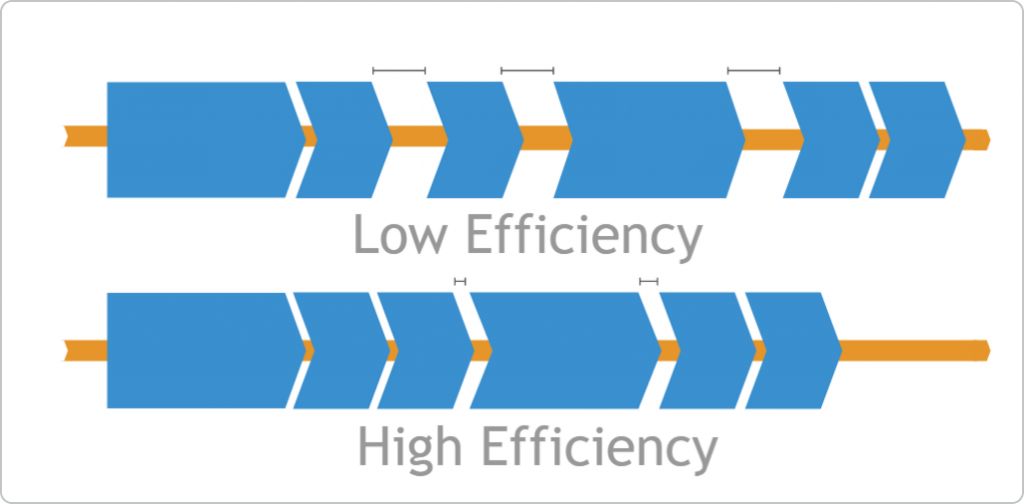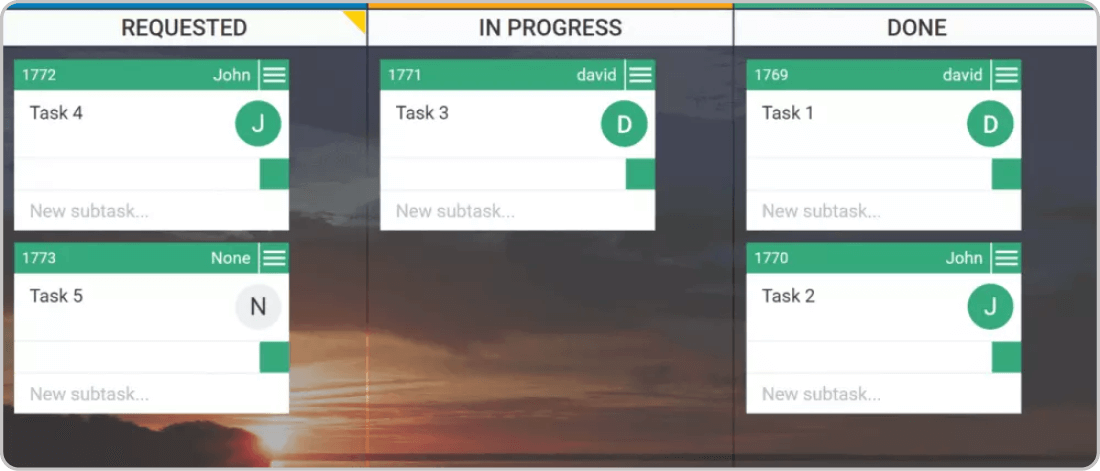"Efficiency is the ability to avoid wasting resources, efforts, and time in doing something or in producing a desired result"... The highest type of efficiency is that which can utilize existing material to the best advantage."
- Jawaharlal Nehru, former Prime Minister of India
The key to keeping pace and competitive advantage in an increasingly busy and rivaling modern market is efficiency. This is especially true for smaller businesses that have to compete with the corporate giants, despite having significantly fewer resources.
While putting effort towards making your business more efficient, it is important to understand how to nurture organizational efficiency on various levels within your operation and what changes will indicate that you have successfully rooted it at the core of your professional environment.
Trying to optimize the efficiency of specific aspects of the company is always a good idea. However, in order to have any significant effect on an entire organization, efficiency must exist on two main levels - personal and process.
What Is Personal Efficiency?
Back in the golden days of factories and manufacturing, the success of a worker would almost always come down to a measure of the speed at which they complete their tasks. In other words, people thought less about efficiency and more about productivity. How much can a single person deliver in a limited amount of time?
Today, competitive, saturated markets and expensive production costs have forced businesses to become aware of the fact that efficiency is much more than just speed.
A truly efficient worker is one who invests their time, efforts, and other available resources into value-generating activities. The measure of the efficiency of a person can be expressed through the relationship between the lead and cycle times of their tasks.
The lead time refers to how long the task has spent within the workflow since its inception, while cycle time refers to how long the task was actively being worked on by a member of the team.

Personal efficiency
An efficient worker is someone who knows how to separate the value-generating tasks from the wasteful activities in order to bring the measure of cycle time as close as possible to the measure of lead time.
Everything else in between these two measurements can be considered waste. Those who are personally efficient prioritize and manage tasks to create a steady, uninterrupted delivery of completed work.
In essence, high personal efficiency is the ability of a person to produce maximum value with minimum waste.
What Is Process Efficiency?
If personal efficiency is a characteristic of individuals within the organization, then process efficiency describes the quality of work transactions and the consistency of the flow of work between different team members or departments collaborating on a project.
Similarly to personal efficiency, business process efficiency is defined by the difference between the time that tasks are being actively worked on and the time they were waiting in a queue or delayed for any reason.
An efficient process is a seamless flow of active execution of tasks across teams and departments. Below is a graphic representation of what a low-efficiency process resembles and how a high-efficiency process might look:
Process efficiency
When tasks cannot easily flow from one stage to the next and they have to queue before the work on them can begin, that is referred to as a bottleneck. Bottlenecks can form in a workflow for various reasons - limited capacity of the team, time constraints, scarcity of specific expertise, etc.
In spite of the reasons, if left untackled, these inefficiencies will undermine the success of projects, departments, and companies at large. Developing an efficient business process is all about eliminating those time-wasting delays.
Syncing Personal and Process Efficiency
Concentrating on just one won't do the trick. In an endeavor to build an efficient business, the goal shouldn't be just to develop a stable workflow but also to grow a team of efficient, value-minded individuals who will support the efficiency of the workflow at large.
"Very-Efficient-Bottleneck' Phenomenon
Let's imagine you have a team of experts with maximum efficiency in the environment of a five-star restaurant at which quality and speed are of the utmost importance. The supplies are delivered just in time, kitchen staff members have already discovered the hack to washing more dishes in record time, and waiters are well-trained to collect orders at lightning speed.
It seems perfect, right? Well, apart from the personal efficiency that has seemingly already been achieved, we have to also consider the handover of the work between each of them and the limited throughput at each stage of their collective process. Their team as a whole must consistently deliver meals to the patrons of the restaurant. These meals must all pass through various stages of progress and between several team members before reaching the end customer.
The problems arise when any one of the stages produces work requests or deliverables at a higher rate than the throughput of the next stage. In the example we've been using, it would mean, for instance, that the restaurant in question has just one great cook, five waiters, and 20 tables to serve. As the orders pour into the kitchen, it will be just that one cook taking care of all of them.
He might be working at the peak of his abilities, not wasting a single second, but the sheer volume of orders will cause serious delays and waste in the process of the team as a whole. In this case, the cook becomes a bottleneck that holds up the work of the other staff members, causing an increase in the total order delivery times, despite the fact that his personal efficiency might be as high as 99.9%. Below, we have aimed to illustrate a bottleneck at work in a scenario in which several stations are involved:
Process efficiency bottleneck
Each party involved might be very proud of their personal efficiency, but the client who will have to wait for their order for an hour will not appreciate any of that. If we only look at the personal efficiency within the team, we miss the greater issue of overall process inefficiency.
However, if we only looked at the process efficiency, we would miss the other instances of waste on the level of individual team members. The two help and depend on each other.
This relationship becomes painfully obvious in the manufacturing industry thanks to the physical indicator of a bottleneck - the accumulation of inventory. Think of car bodies and welding. A factory might have the most efficient welding technique and an automated high-tech quality control solution.
However, if the throughput of the quality assurance unit is not in sync with the welding unit, car bodies will start piling up in a queue. This queue, in its turn, will create overproduction and generation of useless inventory on the other side of the production line, where bodies are expected after the check. No matter how quick and efficient each individual station is, if the process of work handover is not synchronized among them, the end customer will be left unsatisfied or, in this scenario, without a car.
Concentrating on any one part of the equation will always leave you with either efficient workers and a wasteful work transaction system or a smooth flow of work within a team that is far from its optimal efficiency level. If personal efficiency is all about producing maximum value with minimum waste, process efficiency is about pulling that value through the process with minimal losses.
How to Promote a Lean Mindset on All Levels?
In the 50s, Toyota was the first company to tackle the issues of inefficiency in car manufacturing. Back then, a small Japanese car manufacturer revolutionized the way cars were produced and started its incredible rise to become, at present, the largest car manufacturer on the planet.
The secret sauce? Lean manufacturing. The then-unknown car producer was the first in the industry to implement Lean & Kanban in a search to improve project efficiency and productivity. Thanks to their example, we have the best proof that planting a value-driven, waste-free mindset on both the individual and process levels within an organization is the key to achieving success.
To make that possible, they identified every type of waste that was produced on each level of the organization and replaced it with better processes and workflows re-designed with real efficiency in mind.
To implement the same Lean principles of the Kanban method in your organization, follow these 5 steps:
1. Visualize Your Workflow
First, visualize your work. Follow the work breakdown structure method to deconstruct projects into smaller tasks and deliverables. Next, map the processes to identify different stages and work transaction points.
Use this information to set up your Kanban board on a physical wall or a digital work management platform. Make this map of your process accessible to all members of the relevant teams and monitor individual projects on the portfolio layer above the day-to-day workflow of the teams within your organization.
Work visualization on a Kanban board
2. Identify Bottlenecks
Visualizing your work means revealing both expected and unexpected bottlenecks. Use this knowledge to separate queues from active work and track how much time your tasks spend in each of these sections of your Kanban board.
Workflow bottleneck
3. Control and Optimize the Flow
Investigate the reasons behind delays and bottlenecks. Can you remove some of them with better process organization? If the work stops when it all comes down to one person having to send one email, why not automate this process instead?
For the most part, you can remove some of the human element from process management by automating work transactions, routine and recurring tasks, reminders, etc. Yet, automation is not a remedy for every issue, sometimes you simply need to invest in more staff, better training, or more modern equipment.
4. Make Reality-Based Estimations and Decisions
Use a process management platform to track real work progress data. Then, instead of trying to guess how much time a task would take or how quickly a person deals with a particular kind of task, refer to the historical data.
Reality-based estimations will completely change how you allocate your resources and manage your expectations.
Reality-based forecasting with Monte Carlo simulations
5. Monitor Efficiency of the Individuals and their Process
Even a well-managed process cannot be truly valuable unless it is being executed by professionals who can deliver its parts efficiently and effectively. Every one of your team members should be breaking down work into smaller tasks, establishing a steady flow of work by automating low-level tasks and dealing with bottlenecks urgently to make the most of the available resources.
An efficient worker has a sharp focus on what they are doing. They work on one thing at a time because they know multitasking creates waste. The efficient worker doesn't only use resources wisely, but they also don't produce further waste themselves.
To Organizational Efficiency and Beyond
In the end, there is no way around it - if you are to achieve any significant success, you will have to learn how to implement and support both personal and process efficiency in your company. Although he may not have intended it for this context, Ernest Hemingway used to warn that one should "never mistake motion for action".
The modern world moves at an increasingly fast pace, leaving those who don't seek to improve far behind. But don't be fooled, motion is not the same as action. Becoming efficient is not just following some steps and crossing points off the list, nor is it doing more things than you are used to.
True efficiency lies in utilizing the resources you already have to your best advantage by amplifying the contribution of each worker and focusing the flow of work towards the common goal of delivering value to those who expect it.
In the end, no matter how great your system is or how efficient its elements are, always seek opportunities for further improvement.

Dima Moroz
Digital Marketing Specialist
An optimistic rationalist with a passion for writing, marketing, new tech.








